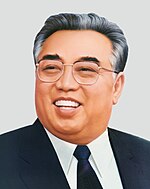Eternal leaders of Juche Korea
| Eternal Leaders of Juche Korea 주체조선의 영원한 수령 |
|
|---|---|
 |
|
 |
|
| Residence | Kumsusan Palace of the Sun (Resting place) |
| Seat | Pyongyang, North Korea |
| Constituting instrument | Constitution of North Korea |
| Formation | 28 December 1972 (President of North Korea) 5 September 1998 (Eternal President of the Republic) 13 April 2012 (Eternal Leaders of Juche Korea) |
| Eternal leaders of Juche Korea | |
| Chosŏn'gŭl | 주체조선의 영원한 수령 |
|---|---|
| Hancha | 主體朝鮮의 永遠한 首領 |
| Revised Romanization |
Juchejoseonui Yeongwonhan Suryeong
|
| McCune–Reischauer |
Chuch'ech'osŏnŭi Yŏngwŏnhan Suryŏng
|
The official designation of Eternal Leaders of Juche Korea (주체조선의 영원한 수령) was established by a line in the preamble to the Constitution of the Democratic People's Republic of Korea, as amended on 13 April 2012, and in subsequent revisions.
It reads (in the original version):
Under the leadership of the Workers’ Party of Korea, the Democratic People’s Republic of Korea and the Korean people will uphold the great Comrades Kim Il Sung and Kim Jong Il as the eternal leaders of Juche Korea...
The President of the Democratic People's Republic of Korea was established in the Constitution of North Korea in 1972. Until then, Kim Il-sung, the de facto ruler of North Korea, held the posts of Premier and General Secretary of the Workers' Party of Korea.
In 1972 the Presidency was established, and Kim Il-sung was elected to the position by the Supreme People's Assembly, the North Korean legislature, on 28 December 1972. Kim held the Office of President until 1994 when he died, and the position was left vacant when he died.
The revised constitution in 1998 abolished the presidency and established the honorific title of Eternal President of the Republic (공화국의 영원한 주석), which was given to Kim Il-sung.
...
Wikipedia


